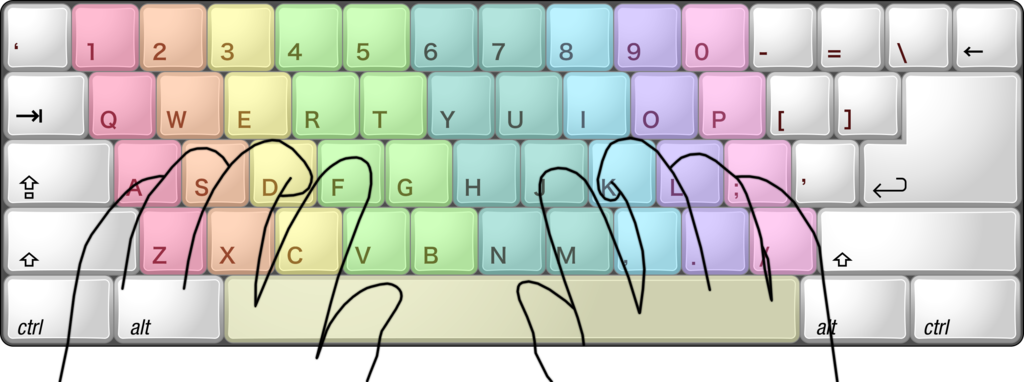Learning touch typing
As soon as my X-Bows keyboard arrived, I also started learning touch typing. It is a method where touch is relied upon instead of vision to locate the keys on the keyboard. In other words, a touch typist can type all the keys through muscle memory. This practice involves a series of concepts, which are summarized in the image below and further explained on the websites ahead.

Resting position of fingers on the home row1
It is worth saying that besides the inherent challenges of transitioning to touch typing, I was also facing changes in keyboard layout (from pt-br to us), design (from conventional to thumb cluster), and language (from Portuguese to English) due to the anglophone aspect of the exercises.
After testing some options, I decided to use these two websites for learning it:
- typing.com
- For theoretical content and basic exercises.
- keybr.com
- For more advanced exercises, adapted to my progress level.
I practiced 30 minutes a day for a month. 15 minutes on typing.com followed by 15 minutes on keybr.com. Additionally, I made a conscious effort to not abandon the touch typing method whenever I needed to use the computer for day-to-day tasks. Yes, the beginning was quite difficult.
Here are some statistics from keybr.com about my learning process. I also wrote down my daily impressions in my journal, which I recapped by week at the end of this text.
All in all, after a month of this routine, I went from 36 words per minute with the visual method to an average of 85 words per minute with touch typing. In addition to benefits in speed and muscle memory, typing properly also provided me with much more comfort. Certainly, it is a skill that I wish I had developed sooner and that is absolutely welcome in our times.
After this learning period, I started using monkeytype.com for maintenance and warming up whenever I feel the need.
Week 1
Certainly, this has been the hardest week. The desire to revert to typing the old way is strong. Basic tasks take a lot of time, to the point where the computer becomes practically unusable.
After a few days, with persistent efforts to position the fingers correctly, simple tasks became manageable.
From the middle to the end of this week, I noticed some signs of smoothness.
Practices have already begun to involve capitalization and a broader set of sequences.
Week 2
Typing speed is increasing. I can now type capital letters quickly.
Practices have begun to involve accentuation and punctuation.
Despite an increase in the number of mistakes, I'm managing to maintain the same speed as before.
Week 3
Getting accents and capital letters right is quite pleasant.
Exercises are progressing without many surprises.
Typing speed continues to increase, but at a slower pace.
Week 4
Mistakes are becoming much less frequent.
I'm already typing in a comfortable and smooth manner.
There is a dilemma between typing faster and making more mistakes and typing slower and being more accurate.
The second option tends to be more effective at the end of the sessions, both in terms of learning and words typed.
Sakurambo, via Wikimedia Commons.
∗ ∗ ∗